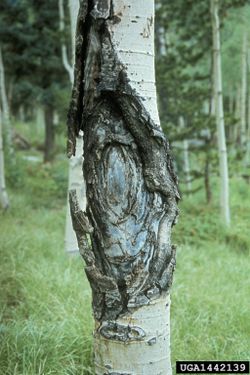Ceratocystis fimbriata
| Literature database |
|---|
| 97 articles sorted by: |
| • year (descending) |
| • research topics |
| • countries/regions |
| • host plants |
| • list of antagonists |

Author(s): USDA Forest Service
Source: IPM Images
Ceratocystis fimbriata Ellis & Halst.
This fungus is widely distributed, causing wilt, cankers and other diseases on a large variety of crops. Infections are often lethal to branches or whole plants. Cankers can become infected by other, secondary pathogens. The fungus may be soil-borne or spreads by insects visiting wounds. Commonly infected crops are, for example eucalypt, coffee, rubber (grey mould on the tapping panel) and root crops like sweet potatoes and taro. Infected mango trees show wilting or sudden decline, but "mango sudden decline" is also caused be other agents.
Taxonomic studies have found C. fimbriata to be a species complex. Strains infecting cacao and plane trees are now classified as separate species, see:
Ceratocystis cacaofunesta and
Ceratocystis platani
| Vernacular names | |
|---|---|
| • Deutsch: | Schwarzfäule der Süsskartoffel |
| • English: | black rot of sweet potato mango wilt mango sudden decline coffee tree canker |
| • Español: | cáncer del cafeto |
| • Français: | pourriture noire de la patate douce |
For details see the respective page in BugwoodWiki.
- Other images of Ceratocystis fimbriata (IPM Images - click to enlarge)


